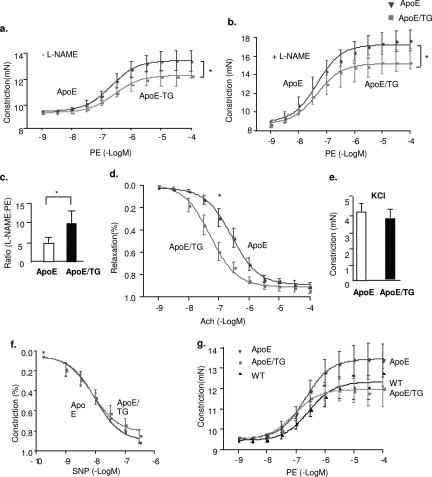Figure 6.
Trx2 prevents hypercholesterolemia-induced EC dysfunction in ApoE-deficient mice. WT, Trx2 TG, ApoE-deficient (ApoE), and ApoE-deficient/Trx2 TG mice (ApoE/TG) were fed with a Western-type diet for 4 weeks and vascular reactivity of aortic rings was determined as described in Figure 3. Only ApoE and ApoE/TG are shown in a–e. For comparison of WT and ApoE, see Supplemental Figure S4 at http://ajp.amjpathol.org. a: Aortic rings were contracted with PE at a full range of doses (10−9 to 10−4 mol/L). Constriction force (mN) is shown. b: Aortic rings were incubated with a NOS inhibitor l-NAME to remove basal NO synthesis and then contracted with PE as in a. c: Ratio of EC50 to PE in the presence versus absence of l-NAME (100 μmol/L). d: Aortic rings were contracted with ACh at a full range of doses (10−9 to 10−4 mol/L). Percentage of relaxation is shown. e: Aortic rings were contracted with 50 mmol/L of KCl. f: Aortic rings were incubated with a NOS inhibitor l-NAME to remove basal NO synthesis followed by a precontraction with PE as in b and were then relaxed with SNP at a full range of doses (10−9 to 10−6 mol/L). g: Comparison of the PE responses among WT, ApoE, and ApoE/TG. Aortic rings were contracted with PE at a full range of doses (10−9 to 10−4 mol/L). Constriction force is shown. All data are presented are mean ± SEM, with n = 4 animals and eight aortic rings per animal. *P < 0.05.

